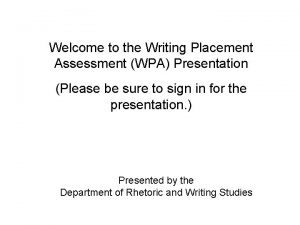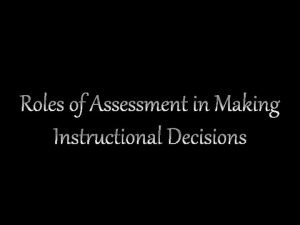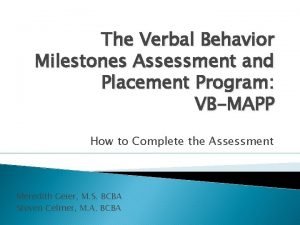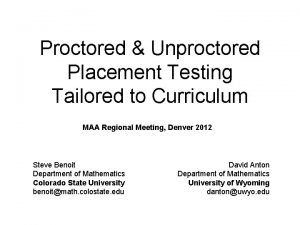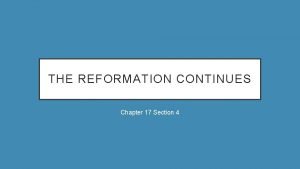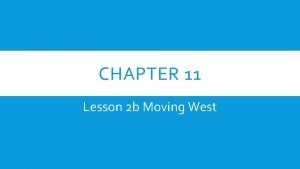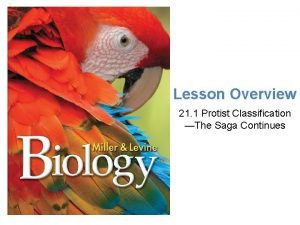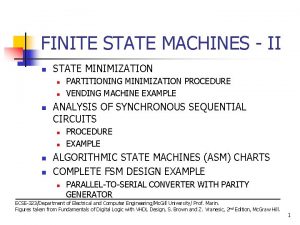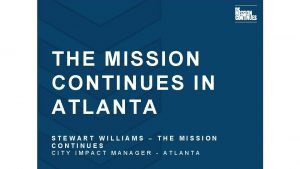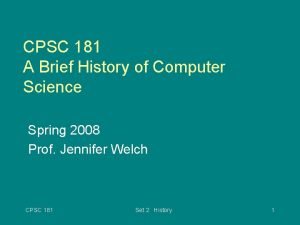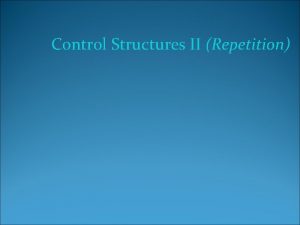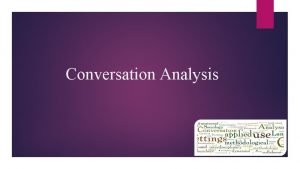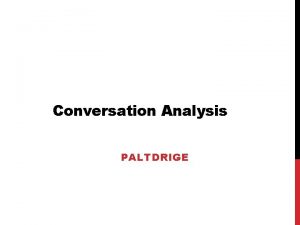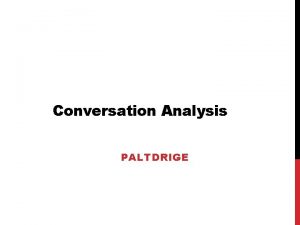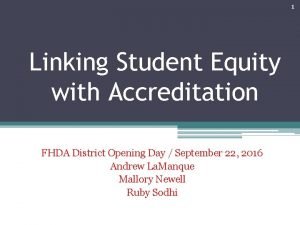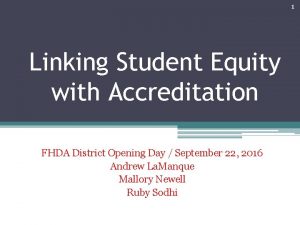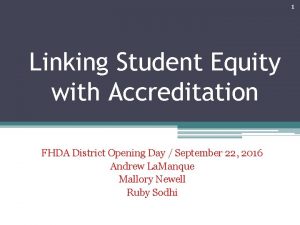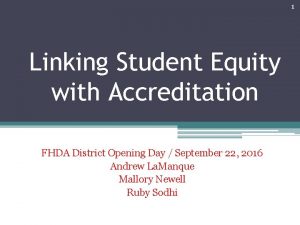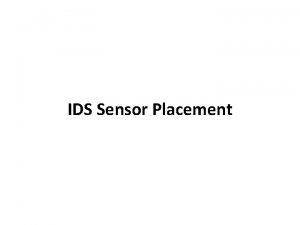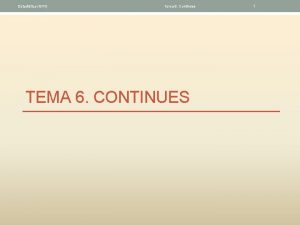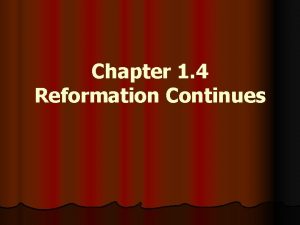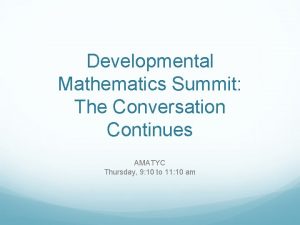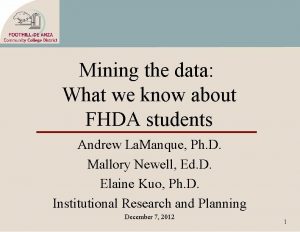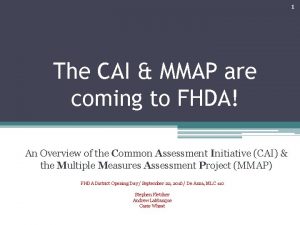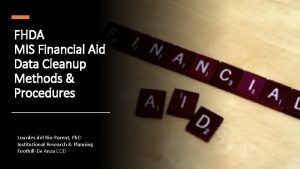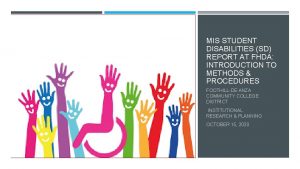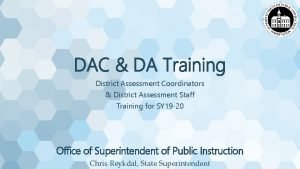Assessment for Placement The Conversation Continues FHDA District





































- Slides: 37

Assessment for Placement: The Conversation Continues! FHDA District Opening Day September 21, 2017 Andrew La. Manque, Associate Vice President of Instruction, Foothill College Casie Wheat, Assessment Center Supervisor, De Anza College 1

What is Assessment? Assessment is a holistic process through which each college collects information about students in an effort to facilitate their success by ensuring their appropriate placement into the curriculum. Examples of this information include the students’ English and math skills, study skills, learning skills, aptitudes, goals, educational background/performance, and the need for special services. Reference: http: //extranet. cccco. edu/Divisions/Student. Services/Matriculation/A 2

Specific examples of community college assessment measures, or tools, include: Placement Tests High School Transcripts Data (courses taken, grades earned, GPA) Early Assessment Placement (EAP) Exam Results Advanced Placement (AP) Exam Results Other Standardized Tests (CSU’s ELM, EPT; SATs; ACTs, TOEFL) College Coursework Background Questions (professional, military experience, etc. ) Non Cognitive Information (grit, motivation, etc. ) Informed Self Placement Counselor or Faculty Interview 3

Welcome! Introductions Warm Up Questions: Do you know how we assess our students for placement into English, Reading, English as a Second Language (ESL), and Math courses? Do you feel our students are being placed accurately? Are there any specific questions that you would like answered today? 4

There will be a test at the end of this presentation. Given current assessment research findings, state mandates and California Community College Chancellor’s Office (CCCCO) policy changes, how can Foothill De Anza (FHDA) evolve to better assess our students? 5

Today’s Agenda Research & Updates from the Field FHDA Assessment for Placement What do other college assessment models look like? Half Time Break! Placement Testing Common Assessment Adoption Schedule FHDA District Retest Policy – October 9, 2017 Multiple Measures Assessment Project (MMAP) & Pilot Results Early Assessment Program (EAP) at Foothill Test! 6

Current State of Assessment Nationally, approximately two thirds of students attending community college are identified as underprepared for college level academics and are assigned to pre college remedial (also known as developmental) courses. Remediation rates are even higher among students of color. Dadgar, M. , Collins, L. , Schaefer, K. “Placed for Success: How California Community Colleges can improve accuracy of placement in English and math courses, reduce remediation rates, and improve student success. ” Career Ladders Project, 2015. http: //www. careerladdersproject. org/wp content/uploads/2015/03/CLP_IP_Brief_37_508. pdf. Accessed 8 September 2017. 7

Research Findings Research shows that a single standardized assessment tool does not accurately assess a community college student’s mastery of a subject (Willet & Karandjeff, 2014). A study on standardized tests and their predictive value for student success in college level courses found that ONE in every THREE students were misplaced in English and ONE in every FOUR were misplaced in Math (Scott Clayton & Belfield, 2012). Willett, T. & Karandjeff, K. (2014). Stepping Up: Progression in English and math from high school to college. Sacramento, CA: The Research and Planning Group for California Community Colleges. Scott Clayton, J. , & Rodriguez, O. (2012). Develop ment, Discouragement, or Diversion? New evidence on the effects of college remediation (NBER Working Paper No. 18328). Cambridge, MA: National Bureau of Economic Research. 8

Updates from the Field Title V, Section 55522 AB 705 (Irwin) Seymour Campbell Student Success Act of 2012: Matriculation: Assessment 9

Title V, Section 55522 Colleges must employ at least two evidence based measures in assessing a student. One of these measures may be an assessment test. The measures chosen must be of different formats to allow students multiple opportunities to illustrate their knowledge and readiness. If another test is selected as a multiple measure, it may not be correlated with the first test. CCCCO Memo: Clarification on—Multiple Measures Used in Student Assessment (9/30/16) 10

AB 705 (Irwin) Seymour-Campbell Student Success Act of 2012: Matriculation: Assessment PASSED! AB 705 requires community college districts to maximize the probability that a student will enter and complete transfer level coursework in math and English within a one year timeframe through the use of multiple measures to achieve this goal. The bill requires community colleges to use high school performance information when determining a students’ readiness for college level English and math. It also prohibits community colleges from requiring students to enroll in remedial coursework unless research proves that the students are highly unlikely to succeed in college level coursework. 11

Has California Found the Answer to More Equitable Developmental Education? From an equity standpoint this bill [AB 705] benefits students of color, as research indicates they do not perform as well on standardized tests, which do not consider students’ test taking ability, stress levels, or social conditions at the time of the exams. The strong consideration of grades is also important, as extensive research has shown them as more effective indicators of overall student success in college. Similarly, an evaluation of a student’s high school profile, including both their academic and extracurricular accomplishments, is a more accurate predictor of potential and subsequent success in Math and English rather than exam scores alone. Preston, Deshawn. “Has California Found the Answer to More Equitable Developmental Education? ” Diverse Education. 26 July 2017. http: //diverseeducation. com/article/99513/ Accessed 8 September 2017. 12

FHDA Assessment Model Foothill English • Accuplacer (Test) De Anza • Accuplacer & Local Essay (Test) • High School Transcript Assessment • EAP Result ESL • Accuplacer & Essay (Test) • CELSA & Local Essay (Test) Math • Accuplacer (Test) • Accuplacer & Local Calculus Readiness Exam (Test) • High School Transcript Assessment • EAP Result • High School Transcript Assessment 13

Assessment Models from Other Colleges 14

Impact of Placement on Student Life Review the next few student profiles and discuss with your neighbor(s) about how the placement result impacted the student’s life. 15

Student Profile 1 Self Reported Ethnicity: Vietnamese Student is a Member of College Special Population (Athlete, DSPS, Veteran, etc. ): No AY 2015 -16 • Enrollment Status: Part Time • Educational Goal: Undecided • Major: Allied Health • Placement Test Results: Math only • Other Coursework/Grades: • Basic Skills Math with passing grades • GE and/or Elective courses with passing grades AY 2016 -17 AY 2017 -18 • Enrollment Status: Full Time • Educational Goal: Transfer to 4 Year • Major: Business Admin for Transfer; then changed to Humanities • Placement Test Results: English; MMAP Pilot eligible • Accuplacer Placement Test Result: Two Levels Below (ENGL 209, 1 A) • High School Transcript Assessment Result: ENGL 1 A • English Grade Tracking: • ENGL 1 A Fall 2016 Grade: B • ENGL 1 B Winter 2017 Grade: B • Other Coursework/Grades: • College Level Math with passing grades • GE and/or Elective courses with passing grades 16

Student Profile 2 Self Reported Ethnicity: Mexican Student is a Member of College Special Population (Athlete, DSPS, Veteran, etc. ): Yes AY 2015 -16 • Enrollment Status: Full Time AY 2016 -17 • No Enrollment AY 2017 -18 • No Enrollment • Educational Goal: Obtain AA • Major: Art; then changed to Business Administration; then changed back to Art • Placement Test Results: • English; MMAP Pilot eligible / Math: Basic Skills • Accuplacer Placement Test Result: Three Levels Below (ENGL 209, 110, 1 A) • High School Transcript Assessment Result: Three Levels Below (ENGL 209, 110, 1 A) • English Grade Tracking: • ENGL 209 Fall 2016 Grade: W • Other Coursework/Grades • Math 220 Fall 2016 Grade: W • PE Activity Course Fall 2016 Grades: A 17

Student Profile 3 Self Reported Ethnicity: Pacific Islander Student is a Member of College Special Population (Athlete, DSPS, Veteran, etc. ): Yes AY 2016 -17 • Enrollment Status: Full Time AY 2017 -18 • Enrollment Status: Full Time • Educational Goal: Obtain AA; then changed to Transfer to 4 Year • Major: Communications; then change to Communication Studies for Transfer • Placement Test Results: English; MMAP Pilot eligible / Math: Basic Skills • Accuplacer Placement Test Result: Three Levels Below (ENGL 209, 110, 1 A) • High School Transcript Assessment Result: ENGL 1 A • English Grade Tracking: • ENGL 1 A Fall 2016 Grade: A • ENGL 1 B Winter 2017 Grade: B • Other Coursework/Grades: • Basic Skills Math with passing grades • GE and/or Elective course with passing grades 18

Half Time Break Any thoughts, comments, questions? Here is what we will tackle next… Placement Testing Common Assessment Adoption Schedule FHDA District Retest Policy – October 9, 2017 Multiple Measures Assessment Project (MMAP) & Pilot Results Early Assessment Program (EAP) at Foothill Q&A 19

Placement Testing: Common Assessment Initiative (CAI) Common Assessment = The California Community College Placement Test The CAI platform will display student common assessment results to all colleges where the student has applied SB 1456 requires that colleges choosing to use a placement test must use the Common Assessment or lose SSSP funding De Anza is a CAI pilot college Anticipated FHDA Adoption Date: De Anza Fall 2018 Foothill – Spring 2019 20

CAI Competency Maps The common assessment will have competencies, not cut scores, which will be used to place students into courses. Competency maps will be assessed for validity and reviewed for disproportionate impact on student groups, if any. When Foothill and De Anza adopt the common assessment, how will department competency maps impact student placement? Enrollment at your campus? Enrollment for our district? 21

Foothill – Math Competency Map Example De Anza – EWRT Competency Map Example 22

Placement Testing: District Retest Policy On October 9, 2017, Foothill and De Anza will adopt a new retest policy. This will impact our students testing for Winter Quarter placement. 23

24

Multiple Measures Assessment Project (MMAP) Research shows that placement tests under place our students, especially our underrepresented populations Using California high school and community college data, the Educational Results Partnership and the Research and Planning (RP) Group have developed decision models with: High school GPA, High school courses taken, and Grades earned. Decisions models maintain a 70% likelihood of student success in the course 25

MMAP Math Pilot Decision Rules @ FH & DA Foothill MMAP Math Pilot Placing students in Math 105 & Math 10 only. De Anza MMAP Math Pilot Placing students up to Math 10, 11, 44, 46, 41. 26

Foothill MMAP Math Pilot Results Fall 2016 27

De Anza MMAP Math Pilot Preliminary Results 33% of students (1, 280 students out of 3, 884) who took a Accuplacer (ACCU) math placement test received a high school transcript assessment (HST) placement. Of those that were assessed: 35% of student's HST placement were higher than ACCU results 38% of student's ACCU results were the same as the HST placement 24% of student's HST placement were lower than ACCU results 28

Foothill’s MMAP English Pilot Decision Rules 29

Foothill MMAP English Pilot Preliminary Results The results in fall 2017 are consistent with the data from 2016 – roughly 40% of students are placed higher using high school GPA and course grade, along with the test result. 30

Early Assessment Program (EAP) All California 11 th Grade students take the California Assessment of Student Performance and Progress (CAASPP): English Language Arts/Literacy Assessment Mathematics Assessment Note: Also known as Smarter Balanced Summative Assessment K 12 has partnered with the California State University (CSU) system to determine placement into college courses using CAASPP results. This is known as the Early Assessment Program (EAP). Now, some community colleges are adopting EAP results. 31

EAP Results for CSU Placement Standard Exceeded = CSU College Level Ready Exempt from CSU placement tests Conditionally Ready = CSU Standard Met Conditionally ready for college level coursework (pending 12 th grade coursework) Possibly exempt from CSU placement tests Not Yet Ready = CSU Standard Nearly Met Need additional preparation in 12 th Grade Required to take CSU placement tests Not Ready = CSU Standard Not Met Needs to demonstrate substantial improvement to be successful in college level course work Required to take CSU placement tests 32

Foothill’s EAP Policy Foothill accepts a result of “Standard Exceeded” to indicate that a student has demonstrated the level of skills acquired through three years of rigorous college preparatory coursework in the subject, math or English. EAP Test EAP Result Course Placement Math Standard Exceeded Math 10, 11, 44, 48 A English Standard Exceeded English 1 A Can we consider other EAP results for placement at FHDA? 33

De Anza’s EAP Policy We are currently not accepting the EAP for placement; however, conversations are ongoing… 34

FHDA Assessment for Placement & ESL Course Sequences What additional assessment tools, alongside the placement test, can we use to place our English second language learners into ESL classes? Examples of assessment tools for ESL include, but are not limited to: English proficiency exams (TOEFEL, i. TEP), IB course credit, SAT results, and faculty assessment/interview. Keep in mind that both Foothill and De Anza have robust ESL populations, which include our full time International Student Programs (ISP) students. 35

Final Thoughts? Given current assessment research findings, state mandates and California Community College Chancellor’s Office (CCCCO) policy changes, how can Foothill- De Anza (FHDA) evolve to better assess our students? 36

Contact Information Andrew La. Manque lamanqueandrew@fhda. edu 650 949 7179 Casie Wheat wheatcasie@fhda. edu 408 8642 37
 Congratulating and responding
Congratulating and responding Sdsu gwar requirement
Sdsu gwar requirement Formative placement diagnostic and summative evaluation
Formative placement diagnostic and summative evaluation Flexi prescoring
Flexi prescoring Unproctored placement assessment
Unproctored placement assessment Chapter 17 section 4 the reformation continues
Chapter 17 section 4 the reformation continues Chapter 1 section 4 the reformation continues
Chapter 1 section 4 the reformation continues The move west continues
The move west continues 21.1 protist classification the saga continues
21.1 protist classification the saga continues Lesson 2 the war continues
Lesson 2 the war continues Chapter 17 section 4 the reformation continues answer key
Chapter 17 section 4 the reformation continues answer key Continues
Continues The mission continues atlanta
The mission continues atlanta Continues on babbage programmable
Continues on babbage programmable A loop that continues to execute endlessly is called
A loop that continues to execute endlessly is called School building leader exam prep
School building leader exam prep Iso 22301 utbildning
Iso 22301 utbildning Typiska drag för en novell
Typiska drag för en novell Nationell inriktning för artificiell intelligens
Nationell inriktning för artificiell intelligens Vad står k.r.å.k.a.n för
Vad står k.r.å.k.a.n för Varför kallas perioden 1918-1939 för mellankrigstiden
Varför kallas perioden 1918-1939 för mellankrigstiden En lathund för arbete med kontinuitetshantering
En lathund för arbete med kontinuitetshantering Personalliggare bygg undantag
Personalliggare bygg undantag Vilotidsbok
Vilotidsbok A gastrica
A gastrica Densitet vatten
Densitet vatten Datorkunskap för nybörjare
Datorkunskap för nybörjare Boverket ka
Boverket ka Debatt mall
Debatt mall Magnetsjukhus
Magnetsjukhus Nyckelkompetenser för livslångt lärande
Nyckelkompetenser för livslångt lärande Påbyggnader för flakfordon
Påbyggnader för flakfordon Formel för lufttryck
Formel för lufttryck Offentlig förvaltning
Offentlig förvaltning Kyssande vind analys
Kyssande vind analys Presentera för publik crossboss
Presentera för publik crossboss Jiddisch
Jiddisch Bat mitza
Bat mitza

